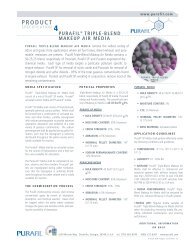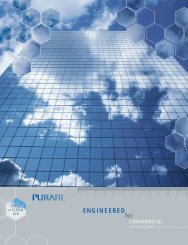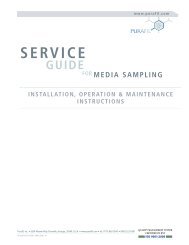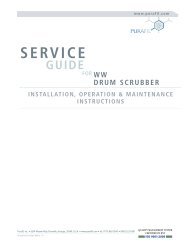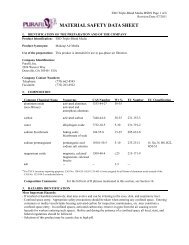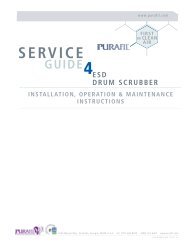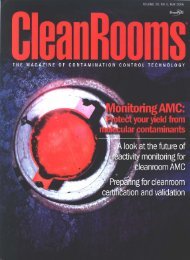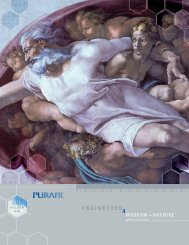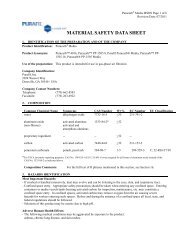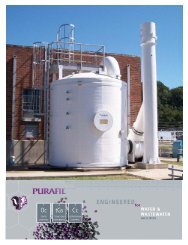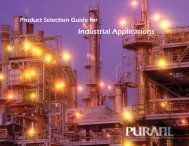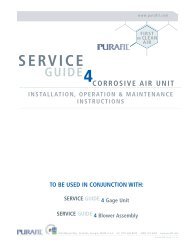ESD Triple-Blend Media - Purafil
ESD Triple-Blend Media - Purafil
ESD Triple-Blend Media - Purafil
Create successful ePaper yourself
Turn your PDF publications into a flip-book with our unique Google optimized e-Paper software.
MATERIAL SAFETY DATA SHEET<br />
1. IDENTIFICATION OF THE PREPARATION AND OF THE COMPANY<br />
Product Identification: <strong>ESD</strong> <strong>Triple</strong>-<strong>Blend</strong> <strong>Media</strong><br />
<strong>ESD</strong> <strong>Triple</strong>-<strong>Blend</strong> <strong>Media</strong> MSDS Page 1 of 6<br />
Revision Date: 07/2011<br />
Product Synonyms:<br />
Makeup Air <strong>Media</strong><br />
Use of the preparation: This product is intended for use in gas-phase air filtration.<br />
Company Identification:<br />
<strong>Purafil</strong>, Inc.<br />
2654 Weaver Way<br />
Doraville, GA 30340 / USA<br />
Company Contact Numbers:<br />
Telephone: (770) 662-8545<br />
Facsimile: (770) 263-6922<br />
2. COMPOSITION<br />
Common Chemical Name Synonyms CAS Number Wt % EC Number EU Classification<br />
aluminum oxide<br />
(non-fibrous)<br />
activated aluminas;<br />
activated and<br />
amorphous aluminas<br />
1333-84-2* 30-35<br />
carbon activated carbon 7440-44-0 30-35 231-153-3<br />
water dihydrogen oxide 7732-18-5 5-30 231-791-2<br />
sodium bicarbonate<br />
sodium permanganate<br />
baking soda;<br />
bicarbonate of soda<br />
permanganic acid<br />
sodium salt solution<br />
144-55-8 15-25 205-633-8<br />
10101-50-5 5-10 233-251-1 O, Xn, N; R8, R22,<br />
R50/53<br />
magnesium oxide<br />
magnesia, calcined 1309-48-4
<strong>ESD</strong> <strong>Triple</strong>-<strong>Blend</strong> <strong>Media</strong> MSDS Page 2 of 6<br />
Revision Date: 07/2011<br />
Adverse Human Health Effects:<br />
- The following medical conditions may be aggravated by exposure to the product:<br />
asthma, chronic lung disease, and skin rashes.<br />
- If the product contacts the skin with water, it may leave a stain of insoluble products on the skin. This stain will be<br />
washed away/rubbed off over a period of time (hours to days).<br />
- In solution, this product may produce a basic (caustic) solution and similar precautions should be taken as those for<br />
basic solutions when such is present.<br />
Environmental Effects:<br />
- If the product is contacted by water, the potassium permanganate may leach out and the water may turn pink to<br />
purple in color. Sodium bisulfite will clarify the water (by chemical reduction), but will give off sulfur dioxide and<br />
should only be used in well ventilated areas. Local regulations should always be consulted and followed.<br />
- If contacted by water, the active ingredients may produce a basic solution depending on amounts of media and<br />
water. If such a solution is produced, the pH should be checked and kept within local regulations by buffering<br />
with suitable neutral or acidic agent.<br />
Emergency Overview:<br />
Inhalation: Move to fresh air. If breathing difficulty occurs or persists, seek medical attention.<br />
Skin Contact: Wash area with soap and water.<br />
Eye Contact: Flush with large quantities of water. Seek medical attention.<br />
Ingestion: Seek medical attention.<br />
Other Information:<br />
This media is classified by the manufacturer for health effects according to EU Directive 1999/45/EC with Xi;<br />
R36/37/38.<br />
4. FIRST-AID MEASURES<br />
First aid measures should be taken as indicated below for the following routes of exposure.<br />
Inhalation: Move to fresh air. If breathing difficulty occurs or persists, seek medical attention.<br />
Skin Contact: Wash area with soap and water.<br />
Eye Contact: Flush with large quantities of water. Seek medical attention.<br />
Ingestion: Seek medical attention.<br />
Notes to Physician:<br />
Product is expected to be non-toxic and only an eye irritant in the powder form. Treatment is recommended to be<br />
symptomatic and supportive. Product may form a basic (caustic) solution, treat the affected person appropriately.<br />
5. FIRE-FIGHTING MEASURES<br />
Suitable Extinguishing <strong>Media</strong>:<br />
Use fire fighting measures that suit the environment.<br />
Specific Hazards:<br />
Corrosive fumes, hydrogen, and carbon monoxide may be generated in the event of a fire.<br />
Protection of Firefighters:<br />
Fire fighters should wear NIOSH approved, positive pressure, self-contained breathing apparatus and full<br />
protective clothing.
<strong>ESD</strong> <strong>Triple</strong>-<strong>Blend</strong> <strong>Media</strong> MSDS Page 3 of 6<br />
Revision Date: 07/2011<br />
6. ACCIDENTAL RELEASE MEASURES<br />
Personal Precautions:<br />
Protective clothing appropriate for the environment should be worn. Goggles or safety glasses with side shields,<br />
NIOSH approved dust masks, rubber or plastic gloves, and full cover clothing covering arms and legs are<br />
recommended.<br />
Environmental Precautions:<br />
See section 3. HAZARDS IDENTIFICATION, Environmental Effects.<br />
Methods for Cleaning Up:<br />
Clean up using dry procedures (broom, shovel, etc.); avoid dusting.<br />
Recovery:<br />
Product may be recovered for use if it has not come in contact with liquid, changed color, or been exposed<br />
to significant amounts of gaseous contaminants.<br />
Neutralization:<br />
See section 3. HAZARDS IDENTIFICATION, Environmental Effects.<br />
Disposal:<br />
See section 13. DISPOSAL CONSIDERATIONS.<br />
7. HANDLING AND STORAGE<br />
Handling:<br />
Use air conveying (vacuum) for bulk removal. If manual handling is used for transfer (from vessel, slingbags,<br />
boxes, or pails), use mechanical ventilation or other measures to remove airborne dust.<br />
Prevention of User Exposure: See Section 8<br />
Prevention of Fire and Explosion:<br />
Contact with strong oxidizers may result in the generation of heat.<br />
Precautions for Safe Handling:<br />
- Confined space entry. Appropriate safety precautions should be taken when entering any confined space.<br />
Entering containers or media vessels/tanks housing activated carbon for inspection, maintenance, etc. may<br />
constitute a confined space entry. In confined spaces, activated carbon may remove oxygen from the air<br />
causing severe hazards for workers entering such spaces. Before and during the entrance of a confined<br />
space all local, state, and federal regulations should be followed.<br />
- Avoid crushing the product to keep dusting to a minimum. As described under Handling above,<br />
mechanical ventilation or other measures may be needed to remove airborne dust.<br />
- Protect from water and exposure to contaminated air (gaseous, particulate, and aerosol contaminated),<br />
otherwise the product may be rendered useless.<br />
Storage:<br />
General good storage practices should be followed.<br />
Suitable Conditions:<br />
Store in a cool, dry area and keep in original, closed containers.<br />
Incompatible Products:<br />
- Product should be kept protected from water and exposure to contaminated air (gaseous, particulate, and<br />
aerosol contaminated), otherwise the product may be rendered useless."<br />
- Contact with strong oxidizers may result in the generation of heat.<br />
Recommended Packaging Materials:<br />
- Corrugated boxes of 350 lb, double wall quality, with 4 mm plastic liners.<br />
- Injection molded, polystyrene pails and lids including a neoprene seal.<br />
Not Suitable Packaging Materials:<br />
Porous materials allowing contact with water, air, and the contaminants contained therein.
8. EXPOSURE CONTROLS / PERSONAL PROTECTION<br />
Exposure Limit Values:<br />
Inert or Nuisance Dust 5 mg/m 3 respirable fraction OSHA PEL<br />
15 mg/m 3 total dust OSHA PEL<br />
<strong>ESD</strong> <strong>Triple</strong>-<strong>Blend</strong> <strong>Media</strong> MSDS Page 4 of 6<br />
Revision Date: 07/2011<br />
Exposure Controls:<br />
Minimize eye and skin contact by using appropriate protective equipment. Use local or general room ventilation to<br />
control airborne dust that may be generated.<br />
Respiratory Protection:<br />
Hand Protection:<br />
Eye Protection:<br />
Skin and Body Protection:<br />
NIOSH approved dust mask<br />
Rubber or plastic gloves<br />
Goggles or safety glasses with side shields<br />
Full cover clothing covering arms and legs.<br />
Hygiene Measures:<br />
Do not inhale dust and avoid contact with eyes.<br />
9. PHYSICAL AND CHEMICAL PROPERTIES<br />
General Information<br />
Physical state: solid<br />
Form:<br />
spherical and cylindrical pellets approximately 1.5 – 6.4 mm (1/16 – 1/4 in.) in diameter<br />
Odor:<br />
no significant odor<br />
Color:<br />
black, dark gray, purple, and blue<br />
Health, Safety, Environmental Information<br />
pH:<br />
not applicable<br />
Boiling point: not applicable<br />
Flash point:<br />
not applicable<br />
Flammability: not flammable under normal conditions<br />
Explosive properties: not explosive<br />
Oxidizing properties: not considered an oxidizing agent; minimal oxidizing potential<br />
Vapor pressure: not applicable<br />
Bulk density: 0.681 g/cc (42.5 lb/ft 3 )<br />
Solubility:<br />
partially soluble in water, more soluble in concentrated acids and alkalies<br />
Partition coefficient: not applicable<br />
Viscosity:<br />
not applicable<br />
Vapor density: not applicable<br />
Evaporation rate: not applicable<br />
10. STABILITY AND REACTIVITY<br />
Stability:<br />
stable under normal conditions<br />
Conditions to Avoid:<br />
none known<br />
Materials to Avoid:<br />
Strong oxidizers - Contact with strong oxidizers may result in the generation of heat.<br />
Hazardous Decomposition Products:<br />
Corrosive fumes, hydrogen, and carbon monoxide may be generated in the event of a fire<br />
Intended Use and Foreseeable Misuse:<br />
Intended use is for air purification from gaseous contaminants. The product is not intended to remove dangerous<br />
particulates or biological contaminants. The product is not intended to purify water.
<strong>ESD</strong> <strong>Triple</strong>-<strong>Blend</strong> <strong>Media</strong> MSDS Page 5 of 6<br />
Revision Date: 07/2011<br />
11. TOXICOLOGICAL INFORMATION<br />
Acute Toxicity: expected to be non-toxic [1] , not tested<br />
Local Effects:<br />
See section 3. HAZARDS IDENTIFICATION, Adverse Human Health Effects.<br />
Sensitization:<br />
Primary skin irritation and corrosivity (rabbits): expected to be non-irritant [1] , not tested<br />
Eye irritation (rabbits): expected to be irritant [1] , not tested<br />
Primary Route of Entry: inhalation, ingestion, skin contact, eye contact<br />
12. ECOLOGICAL INFORMATION<br />
Not determined.<br />
13. DISPOSAL CONSIDERATIONS<br />
Waste From Residues:<br />
Spent media that has removed toxic chemicals should be examined for specific hazards. Local regulations should<br />
always be consulted and followed.<br />
Contaminated Packaging:<br />
not relevant<br />
14. TRANSPORT INFORMATION<br />
International Regulations: not applicable<br />
Proper Shipping Name: not applicable<br />
15. REGULATORY INFORMATION<br />
Regulations:<br />
This section contains information specifically applicable to the chemical product relative to the following<br />
regulations. Local regulations should always be consulted and followed.<br />
SARA Title III (Superfund Amendments and Reauthorization Act)<br />
Section 302 Extremely Hazardous Substances (40CFR355):<br />
Not listed<br />
Section 312 Hazard Categories (40CFR370.2):<br />
Only expected as Acute (eye irritant), see Section 11 TOXICOLOGICAL INFORMATION<br />
Section 313 Reportable Ingredients (40CFR372):<br />
The sodium permanganate portion of the media contains a high percentage manganese compound as a part of the<br />
chemical structure (manganese compounds CAS Reg. No. N/A) and is subject to the reporting requirements of<br />
Section 313 of Title III, Superfund Amendments and Reauthorization Act of 1987 and 40CFR372.<br />
EU Classifications & Labeling<br />
Xi – Irritant<br />
Risk Phrases:<br />
R36/37/38: Irritating to eyes, respiratory system and skin<br />
Safety Phrases:<br />
S3: Keep in a cool place.<br />
S8: Keep container dry.
<strong>ESD</strong> <strong>Triple</strong>-<strong>Blend</strong> <strong>Media</strong> MSDS Page 6 of 6<br />
Revision Date: 07/2011<br />
S24/25: Avoid contact with skin and eyes.<br />
S26: In case of contact with eyes, rinse immediately with plenty of water and seek medical advice.<br />
S28: After contact with skin, wash immediately with plenty of soap and water.<br />
S62: If swallowed, do not induce vomiting: seek medical advice immediately and show this container<br />
or label.<br />
S63: In case of accident by inhalation: remove casualty to fresh air and keep at rest.<br />
16. OTHER INFORMATION<br />
Ingredient R(isk) Phrase Definitions:<br />
R8: Contact with combustible material may cause fire.<br />
R22: Harmful if swallowed.<br />
R35: Causes severe burns.<br />
R50/53: Very toxic to aquatic organisms, may cause long-term adverse effects in the aquatic environment.<br />
Disclaimer:<br />
The information contained herein is accurate to the best of our knowledge. We do not suggest or guarantee that any<br />
hazards listed herein are the only ones, which exist. <strong>Purafil</strong>, Inc. makes no warranty of any kind, express or implied,<br />
concerning the safe use of this material in your process or in combination with other substances. Effects can be<br />
aggravated by other materials and/or this material may aggravate or add to the effects of other materials. The user<br />
has sole responsibility to determine the suitability of the material for any use and the manner of use contemplated<br />
[1]<br />
According to methods described in US Government Document 29CFR1910.1200.



